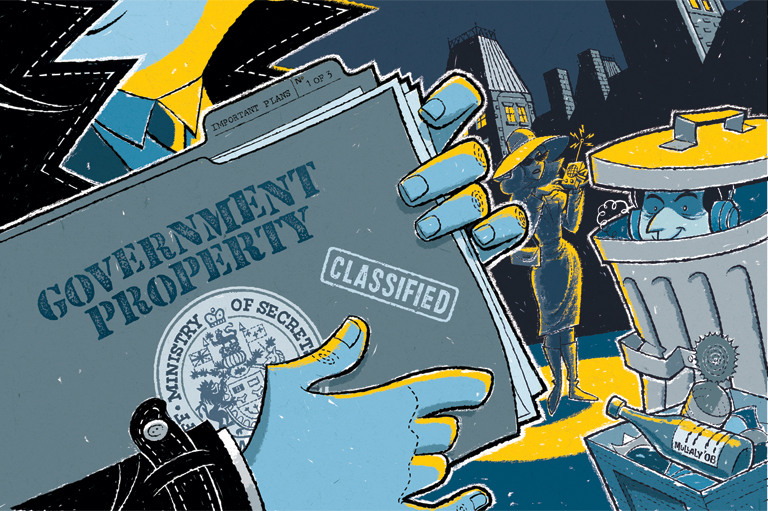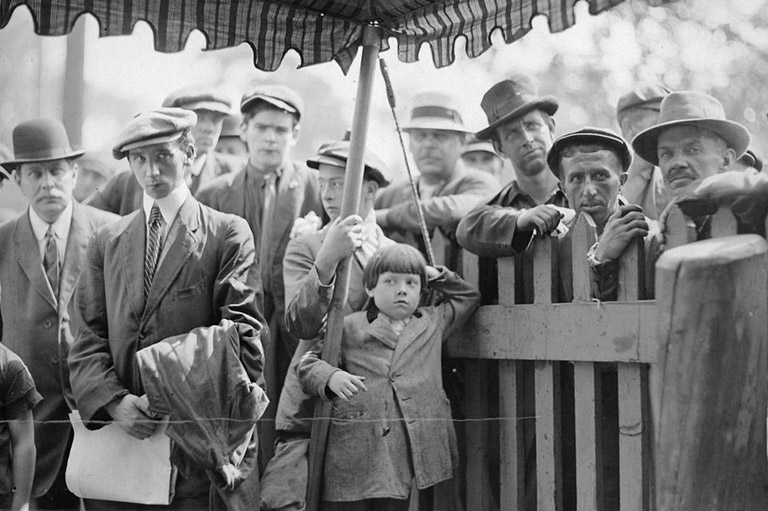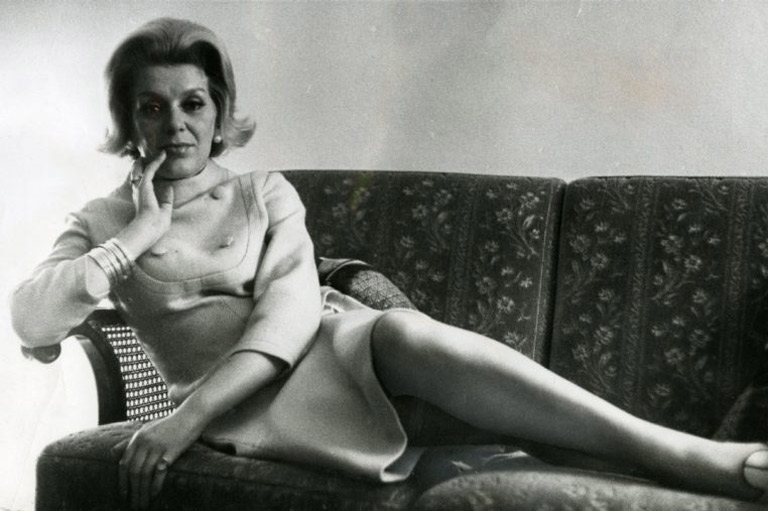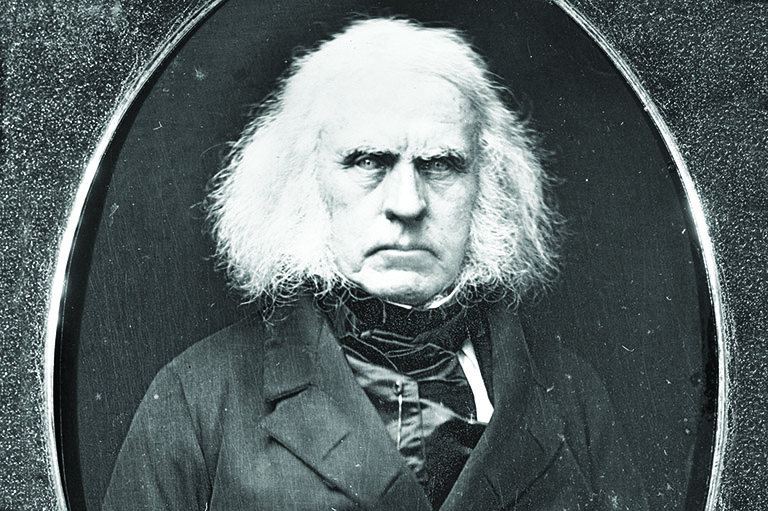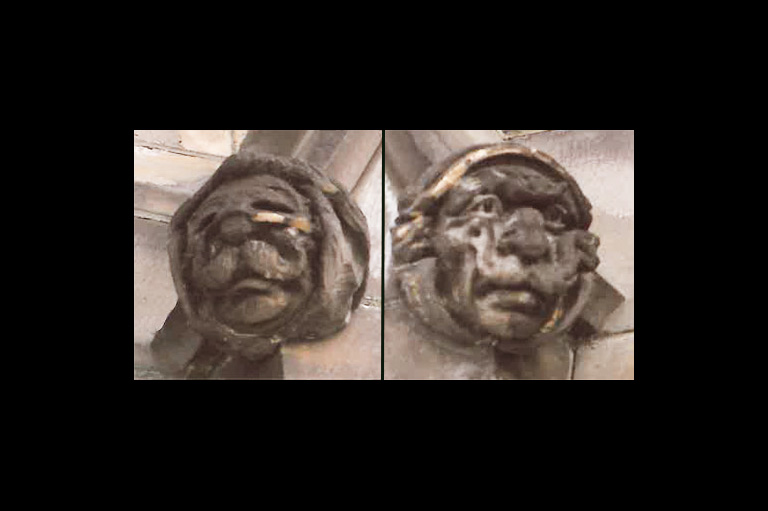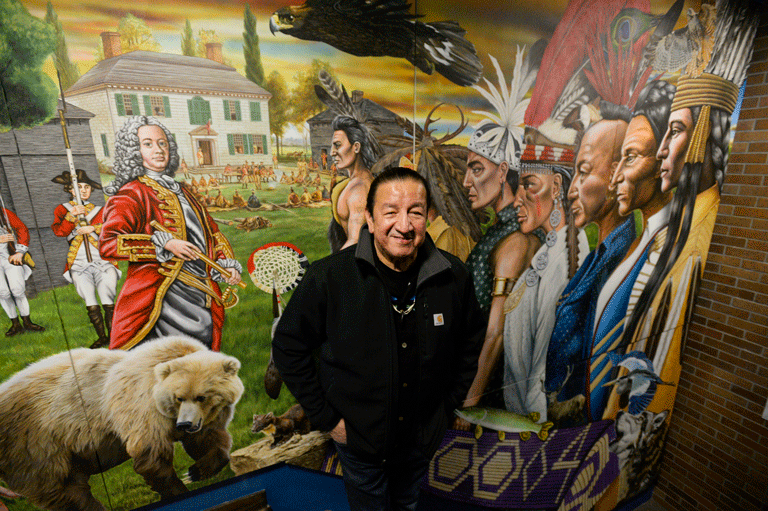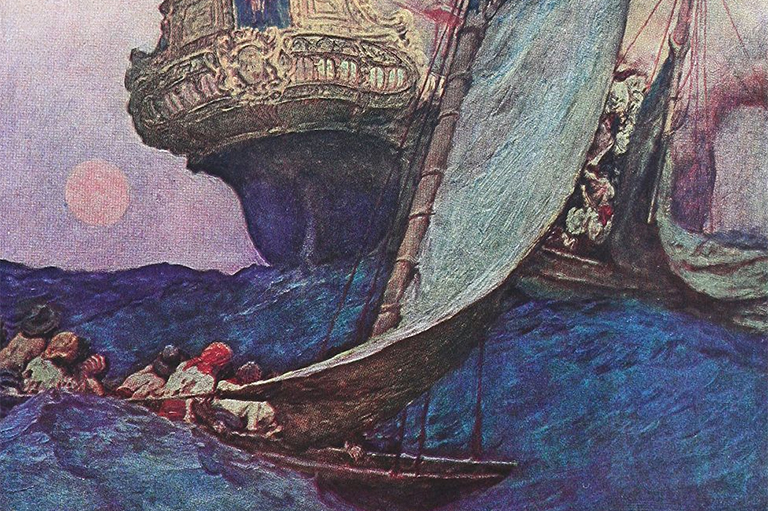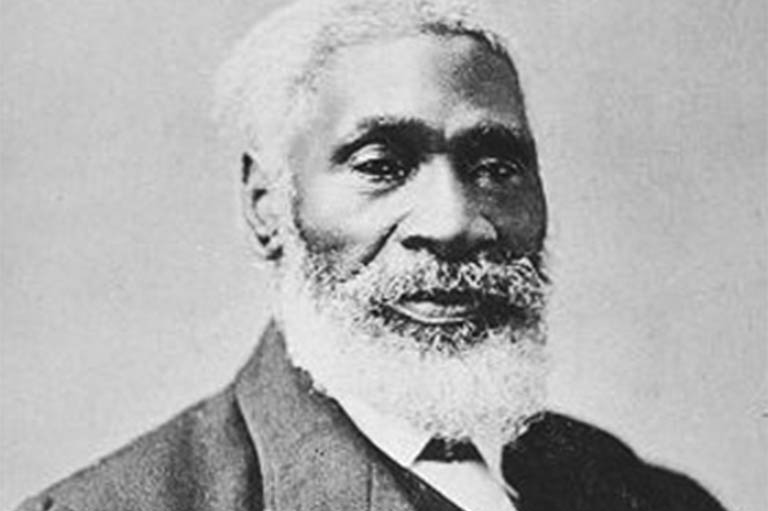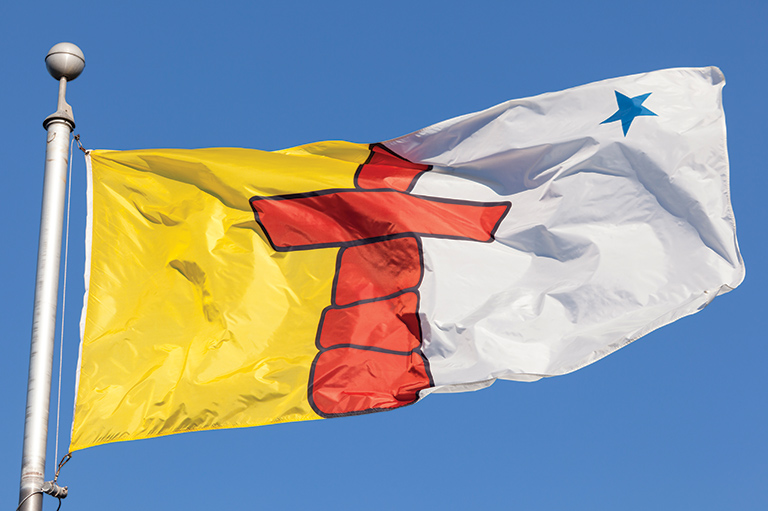Discover a wealth of interesting, entertaining and informative stories in each issue, delivered to you six times per year.
Spying Goes to College
-
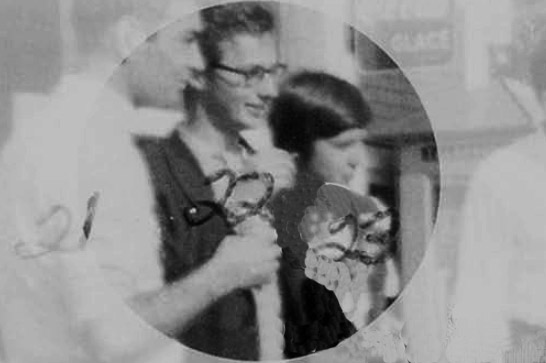 Students from Université Laval in Quebec City, members of the Combined Universities Campaign for Nuclear Disarmament (CUCND), en route to Ottawa in October 1961 for an antinuclear demonstration. This photograph was taken by a fellow member and police informant. The numbers were added by the police for identification purposes.National Archives of Canada / C146273
Students from Université Laval in Quebec City, members of the Combined Universities Campaign for Nuclear Disarmament (CUCND), en route to Ottawa in October 1961 for an antinuclear demonstration. This photograph was taken by a fellow member and police informant. The numbers were added by the police for identification purposes.National Archives of Canada / C146273 -
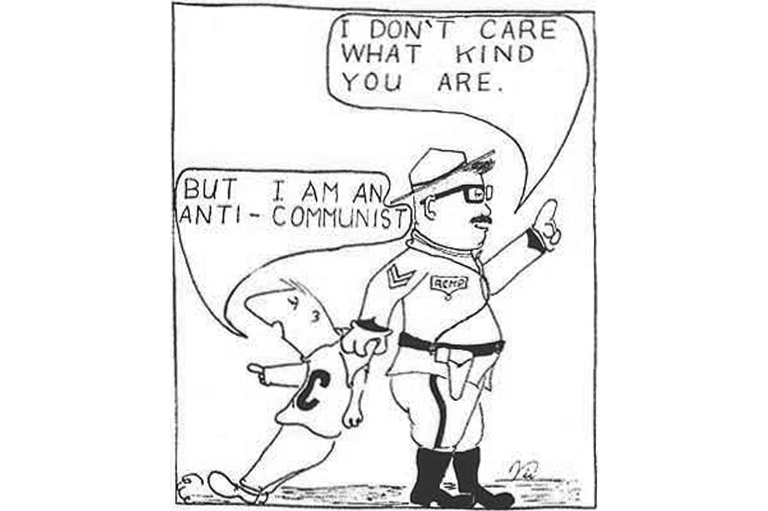 Cartoon mocking the RCMP from The Carleton, Carleton University's student newspaper, January 25,1963.Courtesy The Carleton
Cartoon mocking the RCMP from The Carleton, Carleton University's student newspaper, January 25,1963.Courtesy The Carleton -
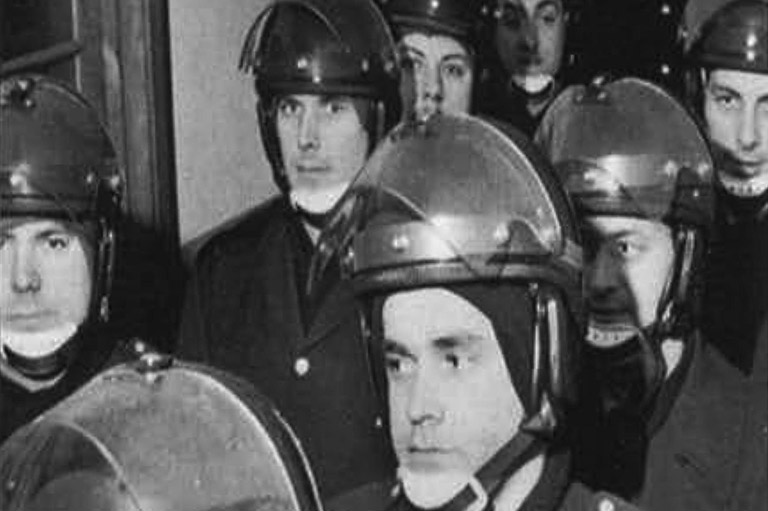 Police assemble at Loyola College, Montreal, to force evacuation of sit-in students and faculty, January 12,1970.Mac Juster / Southam Inc. / Montreal Gazette
Police assemble at Loyola College, Montreal, to force evacuation of sit-in students and faculty, January 12,1970.Mac Juster / Southam Inc. / Montreal Gazette -
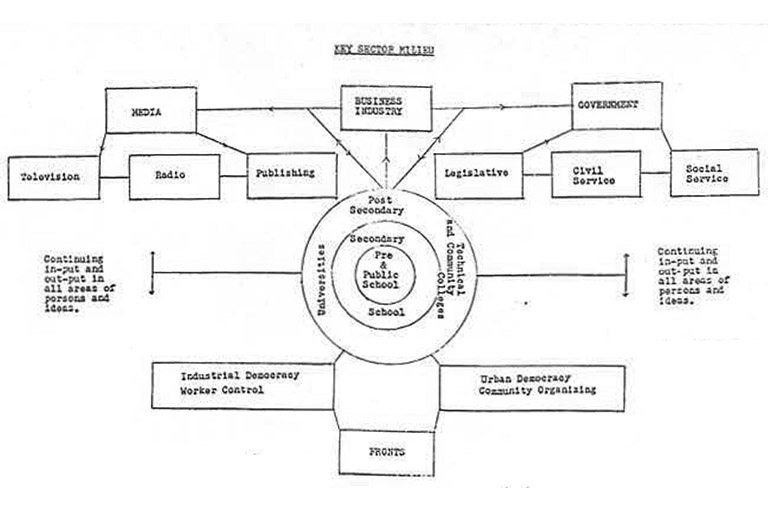 As this diagram from the late 1960s suggests, RCMP security considered the education system to be central to the transmission of ideas they believed to be subversive. By this time, however, subversive categories had expanded beyond communists.Canadian Security Intelligence Service / Access Request 117-98-71
As this diagram from the late 1960s suggests, RCMP security considered the education system to be central to the transmission of ideas they believed to be subversive. By this time, however, subversive categories had expanded beyond communists.Canadian Security Intelligence Service / Access Request 117-98-71 -
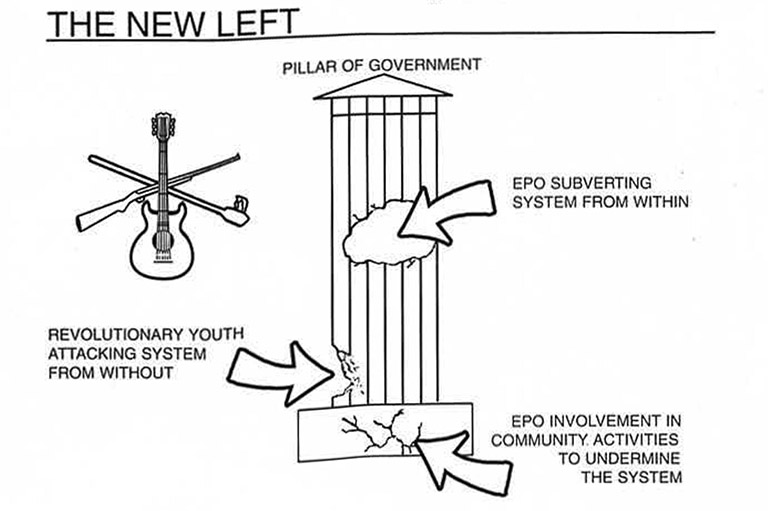 Slide from a September 1971 RCMP presentation to Pierre Trudeau and senior cabinet ministers and bureaucrats about Canadian security threats. The EPO (Extra-Parliamentary Opposition) refers to former student radicals.Canadian Security Intelligence Service / Access Request 117-91-102
Slide from a September 1971 RCMP presentation to Pierre Trudeau and senior cabinet ministers and bureaucrats about Canadian security threats. The EPO (Extra-Parliamentary Opposition) refers to former student radicals.Canadian Security Intelligence Service / Access Request 117-91-102
It was a Thanksgiving full of youthful enthusiasm. Hundreds of university students from across Ontario and Quebec spent the October 1961 holiday weekend campaigning instead of resting.
All were members of the Combined Universities Campaign for Nuclear Disarmament, or CUCND for short, an organization that had its birth in the late 1950s; they had gathered on Parliament Hill in Ottawa, literally under the shadows of the Canadian government whose policy they sought to change.
Among those lugging placards on the sunny fall day was a busload of students from Université Laval in Quebec City. One of the Laval group wore a Brownie camera around his neck, employing it frequently to capture images of several of the demonstrators, some of whom he knew and some of whom he didn’t.
Unlike with most shutterbugs, the final destination for his pictures was not an album of personal memories or a dresser drawer. He had not taken the photos for himself but for his secret employer, the Royal Canadian Mounted Police, who believed the peace movement to be a threat to Canadian security.
When the bus full of students returned home, the photographer made his way to the local RCMP detachment, where he turned over the film, the names of the Laval students who had travelled to Ottawa, and CUCND pamphlets to his police “handler.” Later the student informant helped the police identify many of those featured in the pictures.
In the post-September 11 era, it is important to remember that concern over threats to domestic security is nothing new. What happened on the 1961 Thanksgiving weekend represented what it was that the Royal Canadian Mounted Police, specifically the counter-subversion branch of its Security Service, did during the Cold War.
Sign up for any of our newsletters and be eligible to win one of many book prizes available.
The 1960s are particularly instructive, because in that decade social forces arose which challenged the basis for the security work: Communist subversion, a nebulously defined notion at the best of times, represented the chief threat to Canada. Higher education, the centre of many of these social forces, was of particular interest to the Mounted Police—and it was here that the Mountie concept of a threat would expand.
What had not changed, however, was the idea of a threat. Security agencies cannot survive without the existence of a threat—it does not matter if the threat is real, exaggerated, or imagined—its existence is essential.
The history of these Cold War security activities is especially relevant to the post-September 11 period we now live in—a world where intelligence services created in the Cold War era continue their work to ensure our security, and where real, exaggerated, and imagined threats still coexist.
Part of the inspiration for a photo-taking informant lay only a short distance and sixteen years and a few days away from Parliament Hill. In September 1945, Igor Gouzenko, a twenty-six-year-old cipher clerk in the Soviet Union’s Canadian embassy, left work with top-secret documents concealed in his clothing.
After some initial difficulty in finding someone to listen to his story while avoiding the Soviets searching for him, Gouzenko, with his family, were finally taken in by the Canadian government.
Among his purloined booty were papers revealing the existence of a spy ring that involved not only those the government and the RCMP (because of ethnic and class prejudice) would have expected—workers and ethnic minorities—but those of the upper echelons of Canadian society: academics, scientists, and civil servants.
Gouzenko’s fateful decision to defect did not create a domestic spy agency for Canada. In its modern form, the RCMP’s intelligence role dated from the First World War. It reinforced the long-held view of communism as the main threat to Canadian security, and it expanded both the categories of people prone to the siren call of Red radicalism and the ranks of those whose task it was to investigate the evangelists of such an ideology.
Nor did the Mounties operate in a vacuum. Instead, they acted with the encouragement of the federal government and ordinary citizens. Gouzenko’s revelations that the Soviet Union had been, with the assistance of Canadian Communists, conducting espionage against its wartime ally Canada, fuelled a general sense of betrayal and restored to prominence the animosity many had fell toward communism before the war.
Moreover, with the encouragement of the federal government and many Canadians, Mounties set out to do something about the radical threat. No other approach was possible, since the RCMP, in a burst of Cold War dogmatism, warned in a 1949 pamphlet, “A convinced Communist is a man possessed. He is not amenable to argument or persuasion, or even coercion. Society must always be on guard against him, and each citizen must be prepared to combat his ideas wherever they crop up.”
As the RCMP’s security branch grew after 1945, so did its collection of files. With the Cold War increasing in ferocity as the 1940s tensed to a close, the security game was as much about capturing and protecting minds (fighting subversion) as it was about catching spies (combating espionage).
Save as much as 52% off the cover price! 6 issues per year as low as $29.95. Available in print and digital.
Not surprisingly, with such an atmosphere and approach, higher education seemed particularly vulnerable to attack. Here the young minds of tomorrow’s elite were being moulded. What if the craftsperson was a Communist? What if he or she was using the classroom to convert the captive audience of students to the cause of revolution or some equally nefarious belief?
Socrates had been convicted of corrupting youth in ancient Greece, and corruption seemed to be occurring again in the Canada of the twentieth century. That some of the individuals arrested because of Gouzenko’s evidence were McGill graduates seemed further evidence of the danger. One Quebec newspaper declared: “You send your boy to McGill a Canadian democrat and he graduates an international Communist.”
In the House of Commons the member for Peace River worried that so many Communists held jobs at Canadian universities where they could “undermine the faith of our young people in Canada, in true democracy, and in Christianity.”
On the ground in the early years of the Cold War, Mounties investigated the claims of Communist-ridden campuses. They recruited informants, collected materials, and in plainclothes sat in to hear the occasional lecture or guest speaker. Often the end results were decidedly mixed.
A policeman accompanied by a student informant attended a special lecture at Ottawa’s Carleton College in 1957. The talk that followed under the title “In Defence of Rationalism” was so unintelligible that the police officer, even after a translation from his secret helper, remained in a state of bewilderment. He informed his superiors that his attendance at future lectures in the series was pointless since his informant/interpreter refused to attend any more.
In the 1950s the police also sought communism in the world of student politics. Mock parliamentary elections were a campus tradition. The RCMP followed and reported to Ottawa the results as closely as media pundits on federal election night. The governing rationale was that student election results would provide an accurate indication of Communist support on campus, since those with hidden Red proclivities might be more inclined to reveal their affiliation in the anonymity of a campus ballot box.
That many students voted Communist as a joke did not escape the attention of the police. Thus headquarters dismissed as insignificant the forty-seven medical students who had voted Communist at the University of Alberta, but considered nine students in the conservative school of engineering casting their vote for the Reds worthy of further investigation.
These collective efforts had a more serious purpose: to ascertain the extent of the Communist threat, of subversion. Subversion was by definition a broad and ill-defined concept. To the Mounted Police the only proof necessary was that communism be involved, hence the search for Reds.
By 1959, the RCMP had compiled what it believed to he a comprehensive list of Communists, both open and hidden, working in the field of education. The figure for universities was ninety, which put it in second place behind the 166 Communists in the employ of Canada’s elementary and nursery schools, although a police officer admitted the latter group had little opportunity to inject Marxism into the classroom.
What the police lacked (and some admitted to this) was any evidence that Communists were using their positions to indoctrinate their students. With the Cold War in its full fury, most Canadian Communists would have tried to keep their beliefs to themselves, especially when stories abounded of U.S. teachers and academics being fired because of their political affiliation. Still, the Mounties could not ignore their security training, which, although limited, had repeatedly emphasized the danger communism posed to Canadian society.
One controversial area where higher education, the outside world, and communism seemed to intersect was within the peace movement. In the face of tensions between the two nuclear superpowers, the United States and the Soviet Union, many ordinary citizens were drawn to the peace movement in an effort to curtail the “mutually assured destruction” logic that fuelled the arms race.
To the Mounted Police the efforts of the peace movement (which included Communists) to influence government opinion represented a chance for the Soviet Union to drive a wedge between Canada and its main friend and ally.
The peace movement was also significant because it served as a bridge between the 1950s and the growing campus activism of the 1960s. Many who began with the CUCND migrated to the Student Union for Peace Action or other more radical associations.
Clean-cut Mounties, who had numerous restrictions on their personal appearance, made disparaging (and perhaps slightly envious) remarks about the growing numbers of “dirty and unshaven” “hippie types” and “beatniks” appearing at rallies and other protests.
As the sixties progressed, the level of campus discontent grew. People protested the Vietnam War; they criticized Canada’s relationship with the United States and worried about the Americanization of their country. Issues related to class, race, and gender inspired marches and sit-ins.
Finally, students and others demonstrated against the university itself—its lack of democracy and unresponsiveness to the changing world around it.
In understanding what was happening on campuses, Mountics were as bewildered as university administrators, or students’ parents. Instead of attempting to understand the social context fuelling radicalism, the Mounties blamed it all on communism, a position reinforced by their training and the Cold War.
If Communist involvement in student unrest could not be discovered, it was not because it did not exist but because the police had not delved deep enough to discover it. In taking this position, the RCMP differed in one significant respect from the U.S. intelligence agencies: the Central Intelligence Agency and the Federal Bureau of Investigation more quickly grasped that something new was afoot.
Under way was protest and discontent inspired not by foreign agitators, as the police asserted, but by social causes: the Vietnam War, the civil rights’ movement, fear of nuclear war, popular culture, demographics in the form of the Baby Boom generation, and a host of other causes.
Eventually even the Mounted Police could not ignore the evidence emerging from higher education. The police emphasis on the Communist threat to higher education shifted toward the “New Left” and violence in 1968.*
In April of that year, in an event that shocked many, students working under the banner of the Students for a Democratic Society (SDS) occupied the office of the president of Columbia University, taking time to puff on his cigars and sample his private liquor supply before being beaten and arrested by the police. One of the leaders of the occupation, Mark Rudd, turned up to speak at the University of British Columbia in October of the same year.
Shortly after, another prominent American radical, Jerry Rubin, of the famous “Chicago Eight” who disrupted the 1968 Democratic convention, also spoke at UBC, and in the aftermath of his talk led an occupation of the university’s faculty club. Among the occupying students was a police informant.
By themselves, these two events would not have held the attention of the police. But when on November 21 students at Simon Fraser University (SFU), a location that one Mountie labelled as the most “far out” university in Canada, occupied the administration building for two days, suddenly the police suspicions that had once been applied to communism now had a new home.
An occupation of the computer centre at Sir George Williams University the following January and February, an event that ended with acts of vandalism, only reinforced the Mounties’ conviction of a grand conspiracy: Canadian campus protests, not to mention other radical activity, were being either directed from the United States or coordinated with American activity.
An informant at Sir George Williams University decried the events at his or her university as “preplanned” and part of a movement “that will be more fascist than even that of the Nazi regime in Germany during World War II.”
Appearing before a House of Commons committee three months after the SGWU occupation, the RCMP’s assistant commissioner warned of linkages between American and Canadian radicals. But when pressed by a committee member for evidence, William Kelly replied that his concern had been based more on a “feeling” than on “proof.”
Although the old fear of subversion remained, the campus events of 1968 and 1969, particularly the trashing of the computer centre at Sir George Williams, now supplied the Mounted Police with a new justification for their domestic operations: the threat of violence.
In response, under increasing pressure from the federal government to investigate campus radicalism and separatism in Quebec, the RCMP launched a new effort on campus. One component was a recruitment campaign for informants at universities, because the RCMP had had little success in “penetrating” the student protest movement and because many of its former faculty informants had retired.
Whereas in an earlier time people had only been too happy to assist the police, the sixties were different. Instead, university students were more committed to embarrassing the Mounties by publicly exposing recruitment attempts or simply ridiculing the police as an institution.
The Mounties had difficulty acknowledging that Canadian youth, like others of their generation, were questioning authority, institutions, and the establishment in all their forms, and the primary roots of their unrest came not from without, but within their own societies.
As part of the late 1960s reforms, the RCMP expanded its files on higher education. Headquarters in Ottawa made it clear that radicals now came in a variety of ideological hues beyond the ones traditionally coloured Red: “CP of C member, suspected Trotskyist, self-admitted Marxist, black nationalist, student agitator, anarchist, red power advocate, or an associate of communists.”
Whereas at the end of the 1950s, the Mounties held files on ninety nonstudents at universities, for 1969 headquarters in Ottawa held 357 files on individuals employed in education in Ontario alone.
No scrap of information remained unexamined. The list of materials passed on to Ottawa in 1970 included an account of the appearance at the University of Alberta by American radical (and Chicago Eight member) Abbie Hoffman, an assessment of the Canadian University Press, a mention of a conference on Marxism at the University of Waterloo, a report about a SFU history-student organization, derisive comments from a student informant about an all-female student executive at Brandon University, and descriptions of the formation of a Jewish student group at SFU and a gay organization in Vancouver.
In September 1970, an undercover Mountie joining in a campus festival, “Day One of the New University of Toronto,” collected pamphlets from a wide variety of groups. Unclear as to the top threat to Canada, his collection included material from a gay-rights group, the Varsity Christian Fellowship, and the Campus Crusade for Christ.
The results of the investigations concerned the highest ranks of the RCMP. “The total of the activities of a subversive nature carried out in Canada by many different organizations is very worrying and clearly represents a serious threat to the unity of the country and to the preservation of law and order,” cautioned the director general of the RCMP Security Service, John Starnes, to the federal deputy minister of justice. “Moreover, all the indications are that the level of these kinds of activity across the land is likely to increase rather than to diminish in the next few years.”
The Mounted Police reiterated this message to Pierre Trudeau, his cabinet, and senior government bureaucrats, at a special security briefing in September 1971. Reacting as well to the 1970 October Crisis, the RCMP used a special slide show to paint a dire future for domestic stability in the 1970s. In short, argued Canadas intelligence service, the new decade would render the sixties calm in comparison.
Canada’s famous police force proved, in the end, more proficient at collecting information than using it as a basis for fortune-telling. The social factors of the 1960s that had fuelled campus protest dissipated in the 1970s, and the campuses quieted. Instead of universities experiencing turmoil, the RCMP Security Service did.
Pressured by the federal government to act against radicalism, it launched a campaign of illegal activities, later nick-named the “dirty tricks.” Out of this came a royal commission and the eventual decision to strip the Mounties of the primacy of their security role and create a new agency, the Canadian Security Intelligence Service.
Within CSIS, however, there was an element of continuity with the past. At its start most of its personnel were ex-Mounties and one of the primary justifications for its work, next to espionage, the threat of violence in the form of terrorism, had already been a growing concern in the old Security Service.
Within the continuity there is also relevance for the post-September 11 world. As in the Cold War, a real threat to domestic security exists. But, also as in the Cold War, the potential exists (and indeed has occurred in some cases) for imagined and exaggerated threats to take over, for scapegoating and infringements on civil liberties to occur, and for those who dissent to be discredited by being branded as terrorists in the same way that the label Communist or Red was applied in the Cold War.
It may indeed be a new world after September 11, but when it comes to domestic security agencies whose roots lie in the Cold War, fundamental change may be slow in coming.
At Canada’s History, we highlight our nation’s past by telling stories that illuminate the people, places, and events that unite us as Canadians, while understanding that diverse past experiences can shape multiple perceptions of our history.
Canada’s History is a registered charity. Generous contributions from readers like you help us explore and celebrate Canada’s diverse stories and make them accessible to all through our free online content.
Please donate to Canada’s History today. Thank you!
Themes associated with this article
You might also like...

Canada’s History Archive, featuring The Beaver, is now available for your browsing and searching pleasure!


